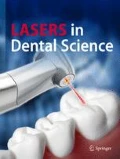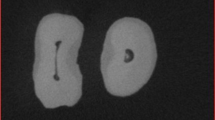Abstract
Purpose
Laser-activated irrigation (LAI) is an activation method that is based on transferring pulsed energy to the irrigation solution by using different fiber tips and generating explosive vapor bubbles with a secondary cavitation effect, causing rapid solution movement through the root canal. This study aimed to compare different types of LAI and ultrasonically activated irrigation (UAI) in terms of cleaning efficacy by using scanning electron microscopy (SEM) images.
Methods
Sixty straight and single-rooted mature mandibular premolars were prepared with ProTaper Ni-Ti rotary instruments up to F4. According to the final irrigation/agitation protocols, four experimental groups (n = 15) were generated as conventional laser–activated irrigation (group 1: C.LAI), photon-induced photoacoustic streaming (group 2: PIPS), shock wave–enhanced emission photoacoustic streaming (group 3: SWEEPS), and passive ultrasonic irrigation (group 4:UAI). The irrigation protocols were performed for 60 s with 2.5% NaOCl and 17% EDTA. Debridement was evaluated using SEM with a scoring system. Apical extrusion was calculated using cube-shaped flower arrangement foam by subtracting the initial weights from the final weights. All data were statistically analyzed.
Results
C.LAI and SWEEPS showed significantly lower debris scores than PIPS and UAI (p < 0.001). However, there was no significant difference between C.LAI and SWEEPS. In the PIPS group, significantly more debris residue was found compared with the other groups. Apical extrusion was significantly lower in the PUI groups than in the laser-activated groups (C.LAI, PIPS, SWEEPS). There was no significant difference between laser-activated groups.
Conclusions
It can be concluded that the use of the C. LAI and novel laser-activated irrigation modality (SWEEPS) provides greater cleaning efficacy compared to UAI and PIPS. Besides, the observed results should not be generalized to teeth with shorter or longer root length and smaller or larger canal preparation with immature root development and open apices. In teeth with resorption, perforation defects or immature roots with open apex, the higher amount of apical extrusion should also be taken into account.

Similar content being viewed by others
References
Caron G, Nham K, Bronnec F, Machtou P (2010) Effectiveness of different final irrigant activation protocols on smear layer removal in curved canals. J Endod 36(8):1361–1366
Ricucci D, Siqueira JF Jr (2010) Fate of the tissue in lateral canals and apical ramifications in response to pathologic conditions and treatment procedures. J Endod 36(1):1–15
Van der Sluis L et al (2007) Passive ultrasonic irrigation of the root canal: a review of the literature. Int Endod J 40(6):415–426
Blanken J, de Moor RJG, Meire M, Verdaasdonk R (2009) Laser induced explosive vapor and cavitation resulting in effective irrigation of the root canal. Part 1: a visualization study. Lasers Surg Med: Off J Am Soc Laser Med Surg 41(7):514–519
Arslan H et al (2013) Effect of agitation of EDTA with 808-nanometer diode laser on removal of smear layer. J Endod 39(12):1589–1592
De Moor RJG et al (2009) Laser induced explosive vapor and cavitation resulting in effective irrigation of the root canal. Part 2: evaluation of the efficacy. Lasers Surg Med: Off J Am Soc Laser Med 41(7):520–523
De Groot S et al (2009) Laser-activated irrigation within root canals: cleaning efficacy and flow visualization. Int Endod J 42(12):1077–1083
De Moor RJ et al (2010) Efficacy of ultrasonic versus laser-activated irrigation to remove artificially placed dentin debris plugs. J Endod 36(9):1580–1583
DiVito E, Peters OA, Olivi G (2012) Effectiveness of the erbium: YAG laser and new design radial and stripped tips in removing the smear layer after root canal instrumentation. Lasers Med Sci 27(2):273–280
Cavalcanti TM et al (2011) Knowledge of the physical properties and interaction of laser with biological tissue in dentistry. An Bras Dermatol 86(5):955–960
Keleş A et al (2015) Removal of filling materials from oval-shaped canals using laser irradiation: a micro–computed tomographic study. J Endod 41(2):219–224
DiVito E, Lloyd A (2012) ER: YAG laser for 3-dimensional debridement of canal systems: use of photon-induced photoacoustic streaming. Dent Today 31(11):122–124-7
Olivi G, DiVito E (2012) Photoacoustic endodontics using PIPS™: experimental background and clinical protocol. J. Laser Health Acad 1:22–25
Lukač N, Gregorčič P, Jezeršek M (2016) Optodynamic phenomena during laser-activated irrigation within root canals. Int J Thermophys 37(7):66
Lukac N et al (2017) Photoacoustic endodontics using the novel SWEEPS Er: YAG laser modality. J Laser Health Acad 1:1–7
George R, Walsh LJ (2008) Apical extrusion of root canal irrigants when using Er: YAG and Er, Cr: YSGG lasers with optical fibers: an in vitro dye study. J Endod 34(6):706–708
Siqueira J Jr (2003) Microbial causes of endodontic flare-ups. Int Endod J 36(7):453–463
Altundasar E, Nagas E, Uyanik O, Serper A (2011) Debris and irrigant extrusion potential of 2 rotary systems and irrigation needles. Oral Surg, Oral Med, Oral Pathol, Oral Radiol, Endod 112(4):e31–e35
Hülsmann M, Rümmelin C, Schäfers F (1997) Root canal cleanliness after preparation with different endodontic handpieces and hand instruments: a comparative SEM investigation. J Endod 23(5):301–306
Goel S, Tewari S (2009) Smear layer removal with passive ultrasonic irrigation and the NaviTip FX: a scanning electron microscopic study. Oral Surg, Oral Med, Oral Pathol, Oral Radiol, Endod 108(3):465–470
Gulabivala K, Patel B, Evans G, Ng YL (2005) Effects of mechanical and chemical procedures on root canal surfaces. Endod Top 10(1):103–122
George R, Rutley EB, Walsh LJ (2008) Evaluation of smear layer: a comparison of automated image analysis versus expert observers. J Endod 34(8):999–1002
Haupt F et al (2020) Effectiveness of different activated irrigation techniques on debris and smear layer removal from curved root canals: a SEM evaluation. Aust Endod J 46(1):40–46
De-Deus G et al (2011) Critical appraisal of published smear layer-removal studies: methodological issues. Oral Surg Oral Med Oral Pathol Oral Radiol Endod 112(4):531–543
Kimura Y et al (2002) Root surface temperature increase during Er: YAG laser irradiation of root canals. J Endod 28(2):76–78
Gutknecht N et al (2005) Temperature evolution on human teeth root surface after diode laser assisted endodontic treatment. Lasers Med Sci 20(2):99–103
George R, Meyers IA, Walsh LJ (2008) Laser activation of endodontic irrigants with improved conical laser fiber tips for removing smear layer in the apical third of the root canal. J Endod 34(12):1524–1527
Ozbay Y, Erdemir A (2018) Effect of several laser systems on removal of smear layer with a variety of irrigation solutions. Microsc ResTech 81(10):1214–1222
Verstraeten J, Jacquet W, de Moor RJG, Meire MA (2017) Hard tissue debris removal from the mesial root canal system of mandibular molars with ultrasonically and laser-activated irrigation: a micro-computed tomography study. Lasers Med Sci 32(9):1965–1970
Laky M, Volmer M, Arslan M, Agis H, Moritz A, Cvikl B (2018) Efficacy and safety of photon induced photoacoustic streaming for removal of calcium hydroxide in endodontic treatment. Biomed Res Int 2018:1–6
DiVito E, Peters O, Olivi G (2012) Effectiveness of the erbium: YAG laser and new design radial and stripped tips in removing the smear layer after root canal instrumentation. Lasers Med Sci 27(2):273–280
Keleş A, Arslan H, Kamalak A, Akçay M, Sousa-Neto MD, Versiani MA (2015) Removal of filling materials from oval-shaped canals using laser irradiation: a micro–computed tomographic study. J Endod 41(2):219–224
Deleu E, Meire MA, De Moor RJ (2015) Efficacy of laser-based irrigant activation methods in removing debris from simulated root canal irregularities. Lasers Med Sci 30(2):831–835
Kamaci A, Aydin B, Erdilek N (2018) The effect of ultrasonically activated irrigation and laser based root canal irrigation methods on debris removal. Int J Artif Organs 41(2):71–75
Akcay M, Arslan H, Mese M, Durmus N, Capar ID (2017) Effect of photon-initiated photoacoustic streaming, passive ultrasonic, and sonic irrigation techniques on dentinal tubule penetration of irrigation solution: a confocal microscopic study. Clin Oral Investig 21(7):2205–2212
Arslan H, Akcay M, Saygili G, Keskı A, MeŞe İT, Gok A, Dalli M (2015) Bond strength of self-adhesive resin cement to root dentin. Comparison of photon-initiated photoacoustic streaming technique with needle and ultrasonic irrigation. Acta Odontol Scand 73(5):348–352
Lukac N, Lukac M, Jezersek M (2016) QSP mode characteristics of 3rd generation ASP powered Er: YAG dental lasers. J LA&HA-J Laser Health Acad 2016(1):1–5
Lukac N, Suhovršnik T, Lukac M, Jezeršek M (2016) Ablation characteristics of quantum square pulse mode dental erbium laser. J Biomed Opt 21(1):015012
Yang Q et al (2020) Micro-CT study on the removal of accumulated hard-tissue debris from the root canal system of mandibular molars when using a novel laser-activated irrigation approach. Int Endod J 53(4):529–538
Ivanusic, T., et al., SSP/SWEEPS endodontics with the SkyPulse Er: YAG dental laser
Galler K, Grubmüller V, Schlichting R, Widbiller M, Eidt A, Schuller C, Wölflick M, Hiller KA, Buchalla W (2019) Penetration depth of irrigants into root dentine after sonic, ultrasonic and photoacoustic activation. Int Endod J 52(8):1210–1217
Jezeršek M et al (2019) Evaluation of Apical Extrusion During Novel Er: YAG Laser-Activated Irrigation Modality. Photobiomodul Photomed Laser Surg 37(9):544–550
Özer SY, Basaran E (2013) Evaluation of microleakage of root canal fillings irradiated with different output powers of erbium, chromium: yttrium-scandium-gallium-garnet laser. Aust Endod J 39(1):8–14
da Costa Ribeiro A et al (2007) Effects of diode laser (810 nm) irradiation on root canal walls: thermographic and morphological studies. J Endod 33(3):252–255
Arslan D, Kustarci A (2018) Efficacy of photon-initiated photoacoustic streaming on apically extruded debris with different preparation systems in curved canals. Int Endod J 51:e65–e72
Gungor OE, Kustarci A (2016) Evaluation of apically extruded debris using two NiTi systems associated with two irrigation techniques in primary teeth. J Clin Pediatr Dent 40(6):490–495
Gregorcic P et al (2014) Synchronized delivery of Er: YAG-laser-pulse energy during oscillations of vapor bubbles. J Laser Health Acad 1:14–19
Jiang L-M, Verhaagen B, Versluis M, van der Sluis LWM (2010) Influence of the oscillation direction of an ultrasonic file on the cleaning efficacy of passive ultrasonic irrigation. J Endod 36(8):1372–1376
Jezeršek M, Jereb T, Lukač N, Tenyi A, Lukač M, Fidler A (2019) Evaluation of apical extrusion during novel Er: YAG laser-activated irrigation modality. Photobiomodul, Photomed, Laser Surg 37(9):544–550
Yao K, Satake K, Watanabe S, Ebihara A, Kobayashi C, Okiji T (2017) Effect of laser energy and tip insertion depth on the pressure generated outside the apical foramen during Er: YAG laser-activated root canal irrigation. Photomed Laser Surg 35(12):682–687
Azim AA, Aksel H, Margaret Jefferson M, Huang GTJ (2018) Comparison of sodium hypochlorite extrusion by five irrigation systems using an artificial root socket model and a quantitative chemical method. Clin Oral Investig 22(2):1055–1061
Özer SY, Basaran E (2013) Evaluation of microleakage of root canal fillings irradiated with different output powers of erbium, chromium: yttrium-scandium-gallium-garnet laser. Aust Endod J 39(1):8–14
Huang X et al (2007) Quantitative evaluation of debris extruded apically by using ProTaper universal Tulsa rotary system in endodontic retreatment. J Endod 33(9):1102–1105
Hachmeister DR et al (2002) The sealing ability and retention characteristics of mineral trioxide aggregate in a model of apexification. J Endod 28(5):386–390
Funding
This study was supported by the Scientific Research Fund of RTE University in Rize/Turkey. (No: TSA-2018-954).
Author information
Authors and Affiliations
Corresponding author
Ethics declarations
Ethical approval
This article does not contain any studies with human participants or animals performed by any of the authors.
Conflict of interest
The authors declare no conflict of interest.
Additional information
Publisher’s note
Springer Nature remains neutral with regard to jurisdictional claims in published maps and institutional affiliations.
Rights and permissions
About this article
Cite this article
Arıcıoğlu, B., Çıkman, A.Ş. & Babacan, M. The comparison of cleaning efficacy and apical extrusion of advanced irrigation activation methods with a novel Er:YAG laser modality: sweeps. Laser Dent Sci 5, 43–52 (2021). https://doi.org/10.1007/s41547-021-00113-2
Received:
Accepted:
Published:
Issue Date:
DOI: https://doi.org/10.1007/s41547-021-00113-2




